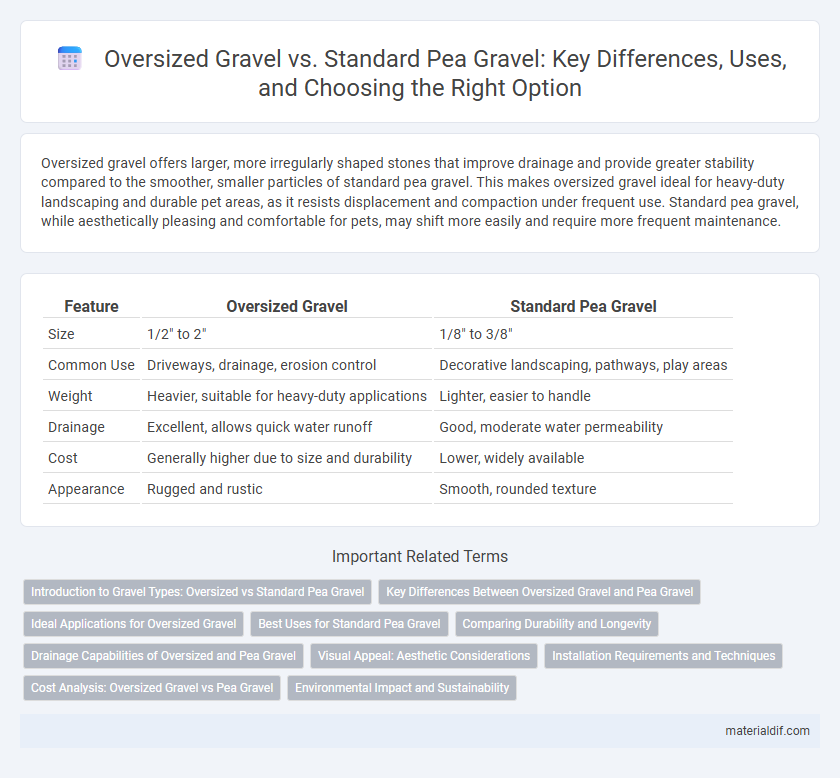Oversized gravel offers larger, more irregularly shaped stones that improve drainage and provide greater stability compared to the smoother, smaller particles of standard pea gravel. This makes oversized gravel ideal for heavy-duty landscaping and durable pet areas, as it resists displacement and compaction under frequent use. Standard pea gravel, while aesthetically pleasing and comfortable for pets, may shift more easily and require more frequent maintenance.
Table of Comparison
| Feature | Oversized Gravel | Standard Pea Gravel |
|---|---|---|
| Size | 1/2" to 2" | 1/8" to 3/8" |
| Common Use | Driveways, drainage, erosion control | Decorative landscaping, pathways, play areas |
| Weight | Heavier, suitable for heavy-duty applications | Lighter, easier to handle |
| Drainage | Excellent, allows quick water runoff | Good, moderate water permeability |
| Cost | Generally higher due to size and durability | Lower, widely available |
| Appearance | Rugged and rustic | Smooth, rounded texture |
Introduction to Gravel Types: Oversized vs Standard Pea Gravel
Oversized gravel consists of larger, irregularly shaped stones typically ranging from 3/8 to 1 inch in diameter, offering excellent stability for heavy-duty construction and drainage applications. Standard pea gravel features smaller, smooth, rounded stones about 1/8 to 3/8 inch in size, ideal for landscaping, walkways, and decorative uses where a softer, uniform texture is desired. Understanding the size and texture differences between oversized gravel and pea gravel is crucial for selecting the right material tailored to specific project requirements and functional purposes.
Key Differences Between Oversized Gravel and Pea Gravel
Oversized gravel consists of larger stones typically ranging from 1 to 3 inches in diameter, providing enhanced drainage and stability compared to standard pea gravel, which measures about 1/4 to 3/8 inch. Pea gravel's smooth, rounded texture makes it ideal for decorative applications and comfortable walking surfaces, whereas oversized gravel offers superior structural support for driveways and heavy-duty landscaping. The size and texture differences influence water runoff, weight distribution, and overall durability in various outdoor projects.
Ideal Applications for Oversized Gravel
Oversized gravel, with particle sizes typically ranging from 1 to 3 inches, excels in heavy-duty applications such as drainage systems, erosion control, and as a base layer for driveways or roads due to its superior stability and permeability. Its larger size prevents compaction and allows water to flow freely, making it ideal for landscaping projects requiring effective drainage or load-bearing support. Unlike standard pea gravel, oversized gravel is less suitable for walkways or decorative uses but is preferred where durability and structural integrity are critical.
Best Uses for Standard Pea Gravel
Standard pea gravel, consisting of smooth, rounded stones typically ranging from 3/8 to 1/2 inch in diameter, excels in applications requiring ease of movement and aesthetic appeal, such as walkways, playgrounds, and drainage systems. Its consistent size and shape provide stable footing and effective water filtration, making it ideal for landscaping projects and patio surfaces. Unlike oversized gravel, pea gravel offers a softer texture and better compaction, enhancing safety and comfort in high-traffic areas.
Comparing Durability and Longevity
Oversized gravel offers superior durability due to its larger, more robust stones that resist crushing and wear, making it ideal for heavy-duty applications like driveways and drainage systems. Standard pea gravel, composed of smaller, smoother stones, tends to compact and degrade faster under pressure, resulting in shorter longevity for high-traffic areas. Choosing oversized gravel enhances long-term performance and reduces maintenance compared to standard pea gravel in demanding environments.
Drainage Capabilities of Oversized and Pea Gravel
Oversized gravel provides superior drainage capabilities due to its larger particle size, allowing water to flow more freely and reducing the risk of waterlogging. Standard pea gravel, with smaller and more uniform particles, offers moderate drainage but can retain some moisture compared to oversized gravel. For landscaping and drainage projects requiring efficient water dispersal, oversized gravel is often the preferred choice.
Visual Appeal: Aesthetic Considerations
Oversized gravel offers a bold, dramatic visual impact with larger, irregular stones that create texture and contrast in landscaping, while standard pea gravel features smooth, small, rounded stones providing a more uniform and subtle appearance. The choice between oversized gravel and pea gravel influences the overall aesthetic, with oversized gravel enhancing rugged, natural designs and pea gravel complementing manicured, refined settings. Color variations and stone shapes play a crucial role in defining the visual appeal, making oversized gravel ideal for statement pathways and standard pea gravel perfect for decorative ground cover.
Installation Requirements and Techniques
Oversized gravel requires a more robust base preparation and heavier equipment for installation due to its larger particle size and weight, ensuring proper compaction and stability. Standard pea gravel, with its smaller, rounded stones, allows for easier spreading and leveling, often needing less intensive subbase work. Both materials benefit from a geotextile fabric beneath to prevent soil mixing and promote drainage, but oversized gravel demands more precise layering to avoid shifting.
Cost Analysis: Oversized Gravel vs Pea Gravel
Oversized gravel generally costs more than standard pea gravel due to its larger particle size and limited availability, impacting transportation and handling expenses. Pea gravel is often less expensive, making it a budget-friendly option for landscaping and driveway projects. Considering long-term durability and application needs helps determine the best cost-effective choice between oversized and pea gravel.
Environmental Impact and Sustainability
Oversized gravel typically originates from larger rock fragments requiring more intensive extraction processes, which can increase habitat disruption and carbon emissions compared to standard pea gravel derived from smaller, more abundant deposits. Standard pea gravel is often favored for sustainable landscaping due to its smaller size, promoting better soil permeability and reducing water runoff, which supports groundwater recharge and limits erosion. Choosing locally sourced pea gravel further minimizes transportation footprints, enhancing its environmental benefits over oversized gravel alternatives.
Oversized Gravel vs Standard Pea Gravel Infographic

 materialdif.com
materialdif.com